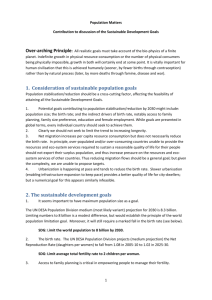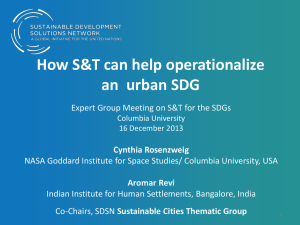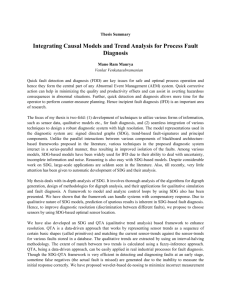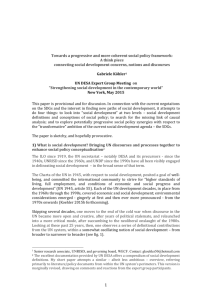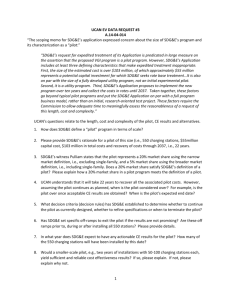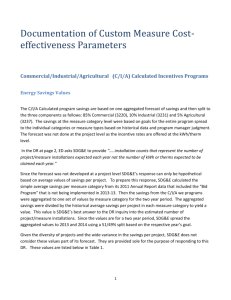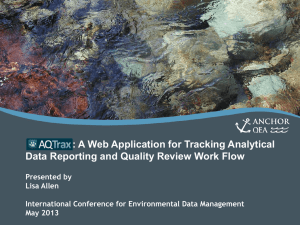A.14-04-014 UCAN`s EV data request 5
advertisement
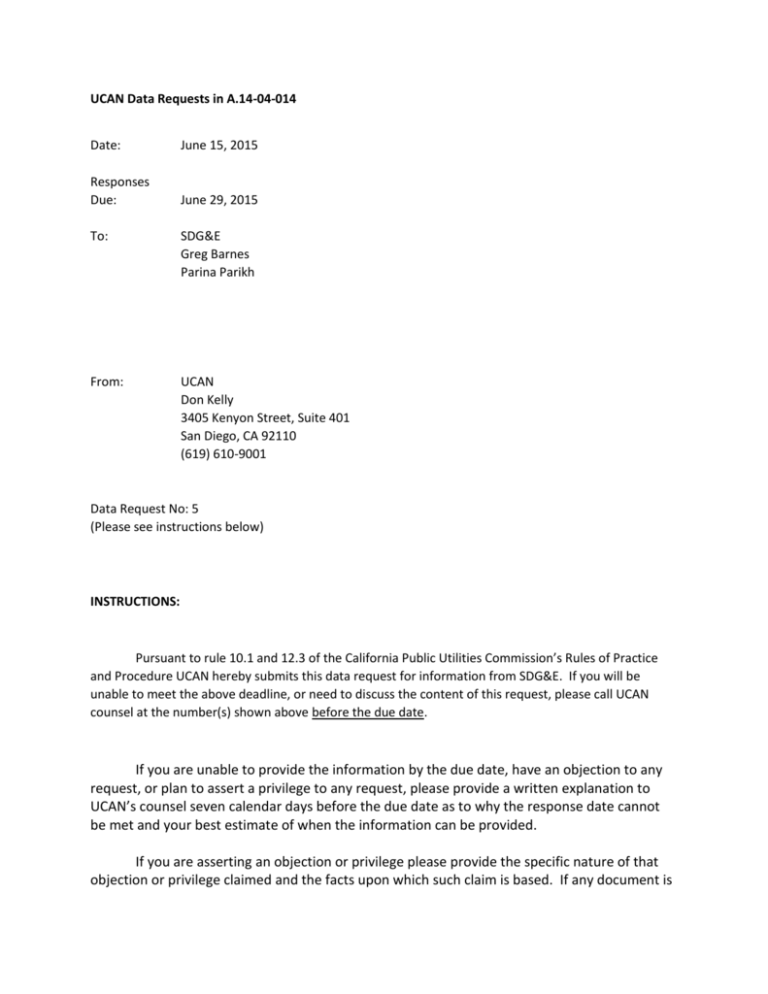
UCAN Data Requests in A.14-04-014 Date: June 15, 2015 Responses Due: June 29, 2015 To: SDG&E Greg Barnes Parina Parikh From: UCAN Don Kelly 3405 Kenyon Street, Suite 401 San Diego, CA 92110 (619) 610-9001 Data Request No: 5 (Please see instructions below) INSTRUCTIONS: Pursuant to rule 10.1 and 12.3 of the California Public Utilities Commission’s Rules of Practice and Procedure UCAN hereby submits this data request for information from SDG&E. If you will be unable to meet the above deadline, or need to discuss the content of this request, please call UCAN counsel at the number(s) shown above before the due date. If you are unable to provide the information by the due date, have an objection to any request, or plan to assert a privilege to any request, please provide a written explanation to UCAN’s counsel seven calendar days before the due date as to why the response date cannot be met and your best estimate of when the information can be provided. If you are asserting an objection or privilege please provide the specific nature of that objection or privilege claimed and the facts upon which such claim is based. If any document is redacted, please clearly identify and describe any information that is redacted from the document and provide an explanation for the redaction. Please identify the person who provides the response and his (her) phone number. Provide electronic responses if possible. If a document is available in Word or Excel format, do not send it as a PDF file. All data responses need to have each page numbered, referenced, and indexed so worksheets can be followed. If any number is calculated, include a copy of all electronic files so the formula and their sources can be reviewed. These data requests shall be deemed continuing in nature so that you shall produce any additional or more current information that come to your attention after your initial responses have been sent up to the time of hearing or settlement. UCAN Data Requests in A.14-04-014, Set 1 1. In this proceeding SDG&E has advanced 2 rationales in support of utility ownership of the electric vehicle service equipment (EVSE) in its proposed pilot: 1) that it was necessary to ensure the electric vehicle (EV) driver received the Vehicle Grid Integration (VGI) rate and price signal, and 2) because SDG&E has a mandate to maintain any equipment in ratebase as used and useful, SDG&E would ensure its continued operation. The proposed settlement provides that the site host will determine if the VGI price signal is to be received by the site host or the EV driver. A. Should the settlement be adopted is SDG&E’s only supporting rationale for utility ownership of the EVSE that the equipment will be maintained by SDG&E as used and useful? B. Has SDG&E ever considered a contractual approach to require that any participant in SDG&E’s pilot must maintain the equipment is good working order, rather than SDG&E needing to own the equipment to ensure it is kept used and useful. UCAN would note that in some of SDG&E’s other contracts, in PPA’s for example, there are there often contract terms requiring a generating facility to maintain their equipment in good working order, i.e., using Good Utility Practice. To date SDG&E has never provided a reason why it could not require program participants to be contractually obligated to SDG&E to maintain the equipment in good working order instead of needing to own the equipment to ensure the equipment is maintained. C. If the CPUC modified the SDG&E pilot settlement to deny SDG&E ownership but would allow SDG&E to administer the program to test their VGI rate, would SDG&E agree to administer such a pilot program? i. If so, and the CPUC required SDG&E to maintain the equipment in good working order, would the fact that the EVSE would not be utility owned prevent SDG&E from maintaining the equipment in good working order? 2. The settlement does not offer any changes to the size (5,500 EVSE), capital cost ($59 million), overall cost ($103 million), or years to cost recovery of the EVSE proposal. In testimony SDG&E noted the that pilots size, length and requirement for utility ownership were necessary conditions to make sure the VGI price signal was passed onto the EV driver and that proper circuit level testing of the grid benefits of its VGI rate could occur across the SDG&E’s various grid circuits. In SDG&E’s application the site owner does not own the pilot chargers. Yet in the settlement it gives the host the choice whether to allow the utility to charge the EV owner directly for EV charging services or to take service directly and pay the VGI Pilot rate and then charge the EV owner that rate or a different rate of its own choosing subject to a host-filed load management plan. a. Please explain how giving the site hosts this option helps manage the grid. b. If the settlement is adopted and the site host determines who gets the VGI price signal (either the site host or the EV driver) how does SDG&E plan to test the VGI rate at the circuit level? c. If the settlement is adopted, what is SDG&E’s rationale for the need to have 5,500 charging stations at 550 sites in its service territory? d. If the settlement is adopted does SDG&E anticipate having the site selection criteria include a requirement that a certain percentage of sites will be reserved where the VGI price signal is given to the driver and alternatively given to the site host? If so, what percentage does SDG&E foresee? 3. Given that the proposed settlement changes many aspects of SDG&E’s EVSE proposal i.e., a site host participation fee, no assurance the VGI price signal will reach the EV driver, and the site host being allowed to charge additional fees, the settlement may affect how many charges per station per day SDG&E can expect. Will SDG&E be performing any new cost effectiveness analysis of the settlement proposal? i. If so, please explain what, if any changes to the cost effectiveness analysis SDG&E intends to make. 4. Given SDG&E’s concerns about grid management in the absence of utility ownership of the EV charging equipment: a. How does SDG&E expect to manage the grid initially if it “gives away” control of pricing? b. As the EV and EVSE markets grow and SDG&E owns a smaller and smaller share of the EV chargers serving the EV market, including those in single-family homes, multiunit dwellings and workplaces, how does SDG&E expect or plan to manage the grid? c. How does the settlement offer any opportunities to test SDG&E’s ability to manage the grid, even if the utility owns all the EV charging equipment, if the control of who gets the VGI price signal is given to the site host? d. What is the most concerning charging location to SDG&E regarding managing the grid: single-family homes? Multi-unit dwellings? Workplaces? Please explain. 5. If the “make ready” approach was implemented, could contract terms be arranged to make sure that in return for the site host receiving a subsidy for infrastructure to the stub, charging services could be restricted to time periods that would avoid contributing to the peak? Please explain. 6. “Participation fees” are rather vague and not really the same as having “skin in the game.” These fees appear to be designed to offset program expenses and not a contribution to capital or investment. a. Did SDG&E consider any “skin in the game” opportunities for site hosts that involved shared investment opportunities rather than just a “participation fee as an offset to operating expenses, e.g., make-ready subsidies? b. The “make-ready” approach was a shared investment opportunity that places the technology risk with the owner of the charging equipment and the infrastructure cost to the stub risk with the utility ratepayer. What is SDG&E’s objection to this form of “skin in the game” or sharing of investment (capital) costs? c. Concerning the participation fee: 1. What exactly is the participation fee? 2. It is anticipated that the participation fee would offset only program expenses or would it also offest installation and equipment costs? 3. What is the size of the participation fee based upon, e.g., cost of trenching, other costs associated with infrastructure to the stub OR a more market-based fee? Explain. 9. SDG&E has expressed concern that without utility ownership, the utility loses control over how charging services are priced and therefore when electric vehicles are charged: Cynthia Fang states: “EVSPs are not subject to the same regulation by the Commission in the way that SDG&E and the other California investor-owned utilities are. Thus, there is no mechanism that would ensure that the EVSPs and/or site owners are required to provide the VGI dynamic hourly rate to the charging customers, which would likely reduce any potential grid and system benefits, as well as limit the potential benefits to charging customers.” (Fang, Rebuttal, CF-5) a. Given the settlement provisions that retain utility ownership of charging stations, on the one hand, but loss of control over how charging services are priced, on the other: (1) How do these two features of the settlement balance in terms of grid management? (2) As the market grows, how will this pilot expand our understanding in knowing how to manage the grid under both utility ownership and third party ownership of EVSE? Please explain.
